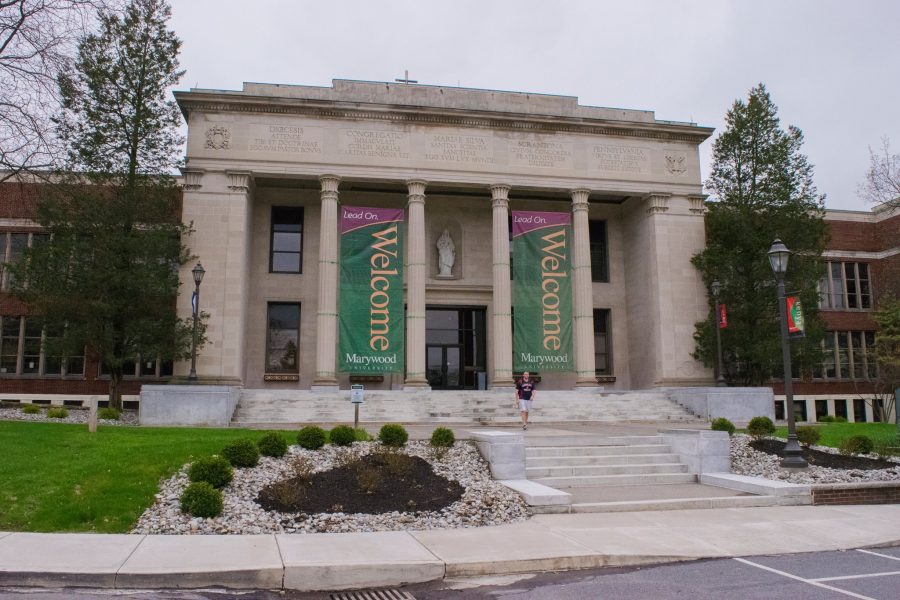College restructuring results in future financial gain, changes for faculty
Photo credit/ Bethany Wade
April 21, 2017
The structure of Marywood’s five colleges will be condensed to three starting on July 1 of this year.
The Wood Word reported that the five current colleges will become the College of Health and Human Services, the College of Liberal Arts and Sciences and the College of Professional Studies, with the School of Architecture falling under the College of Professional Studies.
The new model was selected among six proposed models, all created through collaboration with deans and the president’s executive cabinet. The Faculty Senate also submitted a recommendation for the new university structure to Provost Dr. Susan Turell.
According to Turell, the university had been considering moving to a “four-structure model,” but ultimately decided that three colleges worked better for the size of the university.
“The SRA [Strategic Resource Allocation] is really looking at how are we utilizing our resources the best, what do we want to do strategically to move forward and continue to provide an even better education for the students,” Turell said. “So it just made the most sense to go ahead and move to that number of colleges.”
Ann Boland-Chase, vice president for enrollment services and student success, said she does not see the restructuring having a negative impact on students.
“I think it’s exciting because it may provide new opportunities for students to collaborate with different students from another discipline that they didn’t have the opportunity before,” Boland-Chase said.
Gabby Tolerico, a sophomore music education major, said she is concerned about the majors in the Insalaco College of Creative and Performing Arts being moved to the College of Liberal Arts and Sciences because their current dean understands the needs of students within the performing arts-related majors.
“I think it’s going to be difficult for us to get help from someone who isn’t familiar with what we do because I think that performing arts is a lot different than liberal arts,” Tolerico said. “I think that them being combined is going to create minor issues that we could probably work through.”
Sophomore Art Therapy Major Sarah Pfeil said the college restructuring may be a positive change since if it could help save the university money.
“They could save the money and put it towards the students or in a more helpful way towards the school,” Pfeil said.
Pfeil also said that her major being categorized in a different college is not a big deal to her.
“Art therapy is still art therapy. It is in my eyes still a creative art. It’s a label… so it doesn’t really affect me as much,” she added.
While administrators say that the restructuring should not directly affect students, it will affect certain positions within the university.
“Right now we have five deans,” Turell explained. “One of the deans is going to be retiring…so what this means is that of the four deans, three of them will continue as deans…and we’ll find another duty for the dean that may not head up a college.”
Current deans have applied for the colleges they believe they can lead through “open forums” and then personal interviews for the position.
Tammy McHale, vice president for business affairs and treasurer, said that administrative secretaries to the deans will also be affected by the changes. McHale said that some of the administrative secretaries will be retiring.
A memo from President Sr. Mary Persico, IHM, Ed.D, said the restructuring could potentially save the university $450,000.
McHale explained that the savings from the restructuring will not happen immediately.
“It’ll take a little time but some of it is going to happen in the first year,” McHale said.
Turell said she hopes “that by recouping savings around the reorganization, that will help us have more resources to put into faculty positions.”
She added that she believes the college restructuring is one of the last pieces to be put in place that will enable the Marywood community to move forward in the best way, and that the fall 2017 semester will be a fresh start.
“Hopefully it’ll be less about reacting to what’s happened,” she said. “By the end of spring, maybe beginning of summer, we’ll have some idea about what new majors we want to try to investigate and move forward with. It’s that kind of exciting growth that I’m ready to do.”
Rachel Looker contributed to this article.
Contact the writers: [email protected]
[email protected]
Twitter: @JBonacciTWW @BWilliamsTWW





